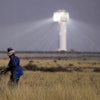Don’t call it a comeback — fracking’s been here for years. But until lately, the drills in the Haynesville Shale field in northwest Louisiana have been a lot quieter.
Production began on the field in 2008 and it was quickly one of the biggest players in the U.S. oil and gas market. But in 2013, as the industry began to decline, production in Haynesville plummeted along with it, and it stayed in steady decline until this year.
According to a recent report in The Wall Street Journal, several companies who’ve stayed in the area have amped up drilling this year with new techniques for re-fracking old wells and getting more out of production. The resurgence is being driven by an increasing export demand for natural gas, a petrochemical building boom along the Gulf Coast and fertilizer factories.
Here’s how the revival looks, by the numbers.
20 percent = The rise in gas production this year at Haynesville. In January, about 6 billion cubic feet a day of gas was being produced at Haynesville — now it’s closer to 7 billion.
34 = Wells at Haynesville that Comstock Resources plans to drill as part of a recent deal with USG Properties. Currently, the company only has three in production in the field. Another company, QEP, also plans to re-frack 30 wells in Haynesville this year.
1.2 billion = Cubic feet of gas produced every day by Chesapeake Energy at Haynesville, one of the biggest companies operating in the field.
1,200 = Future well locations in Haynesville owned by Chesapeake Energy.
$3 = The average gas price, per thousand cubic feet, this year. Technology advances in drilling the kind of long lateral wells that exist in Haynesville have recently made drilling at the $3 benchmark more profitable.
195.8 trillion = Cubic feet of gas natural that is estimated to be in Haynesville, according to U.S. Geological Survey (USGS). The formation, which is mostly in Louisiana, but also stretches into parts of Texas and Arkansas, is also estimated to hold a mean of 1.1 billion barrels of oil.























